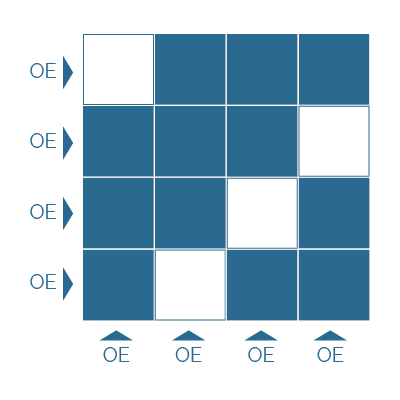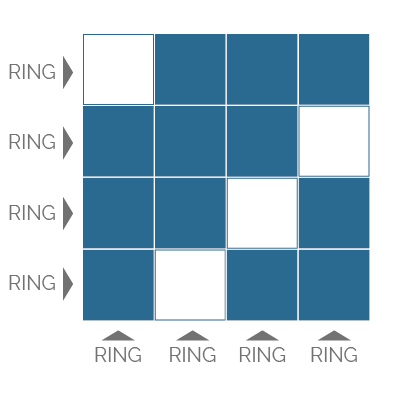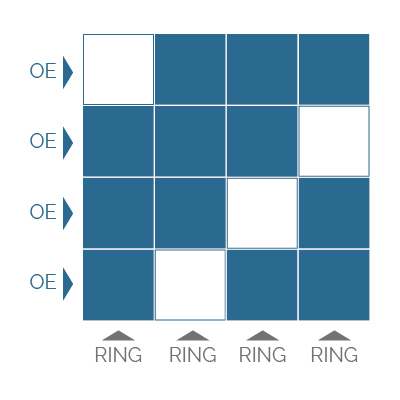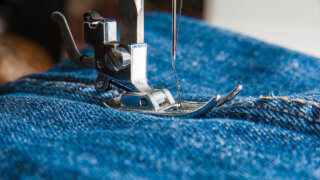Denim Yarn
Yarn Numbering
Yarns used in denim fabrics are termed short-staple spun yarns because they are formed from fibers having a staple length of fewer than 2.5 inches. The cotton fiber usually is just over an inch long. One of the key pieces of yarn information for the development and manufacturing of denim is the choice of yarn size. The terms yarn number, yarn count, and yarn size are used interchangeably to refer to the linear density of a given yarn.
Yarns used in denim fabric are termed short-staple spun yarns since they are formed from short fibers having a staple length of fewer than 2.5 inches. In most cases, the cotton fiber is just over an inch in length. One of the key bits of yarn information used in the development and manufacture of denim is the choice of yarn sizes. The terms yarn number, yarn count, and yarn size can all be used interchangeably when referring to the thickness or linear density of a given yarn. There are various yarn numbering systems used to identify the linear density or relative size of denim yarns. The most common system used today is the English Cotton Count noted by “Ne” (capital N and lower case e). In this numbering system, the yarn number represents the number of hanks per pound of a given yarn. The hank is a standard length of 840 yards. Therefore, six singles cotton count yarn means that one pound of the yarn would contain 6.0 hanks or 5,040 yards (6.0 times 840). The English system is an indirect yarn numbering system. This means the yarn number gets larger, the yarn gets finer.
Yarn Spinning Systems
Ring spinning and open-end rotor spinning are the two most common spinning systems used to produce yarns for denim fabrics.
Open-End Rotor Spinning
Open-end rotor spinning is usually just referred to as open-end spinning. During open-end spinning, a strand of sliver is fed into a metal rotating roll that feeds the sliver into a rapidly rotating combing roll that separates individual fibers from the sliver, yet in turn, feeds the individual fibers into a high-speed rotor where the fibers collect into the required thickness of yarn.
From a production standpoint, open-end spinning can deliver the yarns 7 to 9 times faster than the same size ring spinning yarn delivery. Also, open-end spinning uses fewer processes and employs more automation, making it less labor-intensive. Thus, basic open-end yarn is normally sold at a lower cost than ring-spun yarn of the same yarn size.
Ring Spinning
Because of the popular preference for ring-spun yarn, with its higher strength, more authentic vintage look, and softer hand, many open-end yarn suppliers are producing ring-like yarns sometimes referred to as rough spun. These “effect” yarns are produced by varying the number of fibers to the rotor spinning box to intentionally make the yarn more uneven. The yarn can also be made hairier and softer by roughing up the yarn surface as it leaves the rotor spinning box. A ceramic navel with grooves causes some of the fibers on the surface of the yarn to pull free as the yarn is pulled across the navel. Today’s open-end spinning and ring spinning machines are designed to manufacture predetermined yarn effects called slubs. These effects vary from different lengths, different spacing between slubs, or even variations in the yarn count called multi-count. These structured denim yarns are often designed by the fabric designer who chooses from many patterns that have been simulated by the spinner to show what effect it will have on the fabric. The slub pattern can then be easily downloaded to the spinning machine controls. When slubs are only in the warp direction, the fabric is called warp-slubbed denim. When the slubs are only in the filling yarn, the denim is called filling-slubbed denim and when the slub yarns are in both directions the denim is said to be a cross-hatched denim.
Core spun yarns are produced on ring spinning machines by adding a spandex yarn to the core of the cotton fibers. Air-jet and open-end spinning machines can also produce core-spun elastic yarns for denim. The drafted cotton fibers twist around the spandex core to produce an elastic spun yarn. These yarns can now be made with slubs and multi-count as well thus allowing for a slubbed denim with filling stretch properties.
Ring & Open-End Yarn Combinations
Each spinning system has its advantages and disadvantages. Before the late 1970s, all denim yarns were ring spun. Today, denim fabrics have different combinations of ring and open-end yarns. When you hear such terms as Ring-Ring, OE-OE, and Ring-OE, it’s referring to what spinning system was used to create the warp and filling yarns respectively.

Open-End (OE) Spinning

Ring Spinning

Open-End (OE) & Ring Spinning
Twist
Twist is added to the yarns during spinning.
Z-twist: When the twist in the yarn is in the counterclockwise direction, the twist is called a Z-twist. When looking at a yarn with Z-twist, the fiber orientation will be the same direction as the letter Z. This is the most common twist direction for ring-spun and currently the only direction available for open-end spun yarns.
S-twist: If the yarn is being twisted in the clockwise direction, the twist is called an S-twist. When looking at this yarn, the fibers will be the same orientation as the center portion of the letter S. A Z-twist can only be formed in open-end yarns, while ring-spun yarns can have either Z or S-twist.
Twill may have a right-hand or left-hand angle to the twill line. The appearance of the twill line can be accentuated or diminished by the direction of yarn twist. The effect will be a more or less pronounced twill line. For instance, a right-hand twill and Z-twist give the fabric twill line a low ridge or soft twill, while a left-hand twill and Z-twist give a higher ridge on the twill. On the other hand, a right-hand twill and S-twist give the fabric a higher ridge on the twill, while a left-hand twill and S-twist give the fabric a low ridge or soft twill.
Learn more about the spinning process.
Warping
Warping is the process of transferring multiple yarns, each on a separate yarn package, onto a single collecting package.
In rope dyeing, this package of yarn is referred to as a ball warp. The individual yarns are brought together and formed into a rope. The rope is then wound onto a cylindrical barrel, sometimes called the log. It got its name from when they were originally made from solid pieces of wood. Today, logs are made from metal and covered with rubber. The log does not have end flanges. The yarn collecting package is referred to as a beam. When the yarns are laid in sheet form onto a cylindrical barrel with side flanges and yarn ends lying parallel to one another. In either case, the supply yarn packages are placed on spindles which are located on a framework called a creel.
Traveling package creels are V-shaped creels with the current packages of yarn being used to make the beam or log placed on the outside of the V. The replacement yarn packages for the next warper set are placed on the inside of the V. When the running packages are depleted, the empty packages on the creel are rotated so that the spent packages then move to the inside of the V and the previously stored full packages move to the outside of the V, ready to be processed into the next warp. This system eliminates time lost in creeling up new yarn packages.
Continuous magazine creels are straight line creels with enough package holders so that each end running has a reserve yarn package placed beside it. The tail-end of the running package is tied to the beginning end of the reserve package. Once the running package is depleted, the yarn package transfers over to the reserve package and the warper continues to run. This is a random method of creeling yarn packages and is most effective by mills running beams in balls with a standardized number of ends, yarn types, or yarn counts on them.
Truck creels describe a system where one creel is running yarn packages while a second creel is being loaded. Once the current set of packages is exhausted, the creel is moved out of the way and the second creel is moved into the running position. The yarn ends from the second creel must be pulled forward and threaded through the appropriate guides. In ball warping, anywhere from 250 to 400 yarns or ends are pulled from the creel. These yarns then pass through a comb-like device sometimes called a hack or reed which keeps each warp yarn separate and parallel to its neighboring ends.
Every one to two thousand yards, a lead string is interlaced through the warp yarns at the hack. This string aids the yarn separation into sheet form during the subsequent rebeaming operation after dyeing. The yarns then go through a funnel-shaped device called a trumpet which condenses the sheets of yarns into rope form. The trumpet is located at the base of the warper head and moves back and forth guiding the rope of yarns onto the log. Once the yarns have been wound onto the log, this package is known as a ball warp and is ready to be delivered to the indigo rope dye range.
During beam warping, yarns from the creel are in a sheet form and are wound parallel to each other onto a flanged beam. These yarns will not go through the indigo dye range but can be either slasher dyed or left natural. If left natural, the resulting fabric could then be piece dyed or used as a natural denim which could even be later garment-dyed, if desired. Another option could be to beam dye the yarns using something other than indigo dye.
Dyeing
Most denim fabric is yarn-dyed. The warp yarns are dyed with indigo while the filling yarns are left undyed. However, solid shades are becoming more popular and can be dyed by various methods.
With the advent of denim garment washing techniques, the construction and dyeing techniques used are of utmost importance. The selection of yarn, the consistencies of the indigo dyeing process, and its modifications have become crucially important in determining the quality and performance of indigo denim products. The properties of the indigo dye account for the wide variety of color designs that are available on denim products.
Indigo is unique as a major textile dye because the indigo dyeing process naturally ring-dyes the cotton yarns. Unlike almost all other commercially successful dyestuffs, the indigo dye concentrates in the outer layers of the yarn during the dyeing process. This produces an intensive ring of color around a white core in the yarn, thus the name ring dyeing. With most dyes, if ring dyeing occurs it’s considered a dyeing defect.
Indigo dye, an intense blue, is insoluble in water and will not dye cotton fiber. In order to dye cotton yarn, the indigo must first be converted into a water-soluble lueco form and then applied. This chemical process is known as a reduction. Reducing solutions containing sodium hydrosulfite and sodium hydroxide chemically change the indigo dye into its soluble form. This process also converts the dye from its intense blue color to a very pale greenish-yellow color. The outer layers of the yarn readily absorb this lueco form of indigo. Once in the yarn, the indigo is returned to the insoluble form by oxidation. During oxidation, the ropes of yarn pass through the air in a process called skying. The oxygen in the air converts the dye back to its original insoluble form and its blue color returns.
In traditional rope or ball warp dyeing, the following steps are involved:
Scouring > Indigo dye application > Rinsing > Drying
The ropes are first fed into one or more scouring baths which consist of wetting agents and detergents. The purpose of these baths is to remove naturally incurring impurities found on the cotton fiber such as dirt, minerals ash, and pectin. Additionally, the waxy layer on the fiber which repels water is also removed. It’s very important to remove these materials to guarantee uniform wetting and dyeing. The ropes are subsequently fed into two or more water rinsing baths. The key to this process is the dyeing segment where the indigo dye is added in layers to the outer surfaces of the yarn.
Warp/Ball Warp Dyeing
In warp or ball warp dyeing, the yarn is passed into a vat of soluble indigo dye that exhausts on the surface of the yarn and is then oxidized. This results in a small amount of dye being deposited on the surface, yielding only a light blue dyed yarn. In order to obtain a deeper blue shade. The dye must be built up in layers by multiple passes of the rope of yarn into the subsequent vats of soluble dye and then into the air for oxidation. Each of these cycles is called a dip. Normally this process is repeated from three to nine dips in order to build up a rich, deep blue color.
If even darker shades are required, a sulfur black or sulfur navy dye can be applied to the yarn.
- Sulfur Top: Sulfur dye is applied after the indigo dye.
- Sulfur Bottom: Sulfur dye is applied prior to the indigo dye.
When a sulfur bottom is required, the scoured ropes of yarn are then fed into a bath of a reduced sulfur black dye. Similar to indigo, sulfur dyes are water-insoluble. They must be reduced to a water-soluble form prior to application. Unlike indigo, the sulfur dye can penetrate into the core of the cotton fiber thus darkening the overall color shade. Once the reduced sulfur dye is applied to the ropes of yarn the dye is allowed to oxidize to its normal water-insoluble form. The ropes are then fed into one or more water rinse baths. These baths remove any unfixed sulfur dye that might contaminate the indigo dyeing process. Then the normal indigo dyeing process begins.
Rope Dyeing
In rope dyeing, ball warps are continuously fed into the rope or chain dyeing range for application of the indigo dye. Typically 12 to 36 individual ropes of yarn are simultaneously fed side by side into the range. The ropes are kept separate from each other throughout the various parts of the dye range. Each rope of yarn typically contains 250 to 400 individual cotton yarns. The actual number of ends in each ball is determined by the number of ends that are required on each section beam.
For example, if we have 30 ropes in a dye range and each rope has 350 ends, then the dye range will be producing a dye set with 10,500 ends (30 times 350 ends each). The dyed yarns from each rope are separated onto a section beam. In this dye set, there would be a total of 30 section beams. In most cases, this would mean that this dye set could be broken down into two subsets of 15 sections beams with each containing 5,250 ends.
The ropes of yarn are then fed into the reduced indigo dye baths. Once reduced, the indigo dye takes on a pale greenish-yellow shade. The yarns are then skyed as much as 30 to 40 feet into the air to allow the oxygen in the air to convert the indigo back to its normal water-insoluble blue shade. As the yarns oxidize, they change from a light greenish-yellow shade through various darkening shades of blue-green until they become the deep blue indigo shade. Denim shades require as few as three or as many as nine dips and skying processes. The ropes are then rinsed in several water baths to remove any unfixed or surface dyed deposits. Another option would be to add another sulfur top after the indigo dye has been applied. The sulfur dye still migrates towards the core of the fiber but the sulfur top produces a different type of color performance, especially in garment washing procedures. The sulfur top process is followed by one or more water rinses to remove any unfixed dye.
After rinsing, the yearn ropes pass through squeeze rolls to mechanically extract water. The yarns are then dried and coiled into large tubs. The typical drying apparatus is multiple stacks of drying cans. These metal cylinders are filled with pressurized steam. Care must be taken not to over-dry the yarn or the dye will excessively migrate to the surface of the yarn, increasing the tendency of the color to crock. Additionally, if the surface of the drying can is too hot, the yarn can be overstressed producing an undesirable shiny or ironed appearance.
Coiling takes place after drying. The ropes exit the drying cans and are lifted high into the air and then coiled into large trucks or tubs. Each individual rope is placed into a separate truck. After drying, the color of the yarn is checked either visually or instrumentally. With many indigo dye ranges, the color of the yarn is continuously monitored by a color spectrophotometer which is electronically linked to the controls of the indigo dye baths. This type of control system can automatically adjust the dynamics of the process to obtain the most consistent color from the beginning to the end of the many thousands of yards of yarn contained within a single dye lot.
In order to minimize the color variability often seen between denim panels after garment washing, denim manufacturers will try to use the same dye set or lot to fill a customer’s order. Each roll is sampled and a piece of fabric from each is sewn together into a patchwork blanket and garment-washed using the customer’s garment washing recipe. The swatches are then shade sorted using a color computer and if they fall within the guidelines of the customer, the cloth is shipped to the customer.
Once the warp yarns are rope dyed, it is then necessary to change the yarn alignment from rope form to sheet form prior to entering the next process which is slashing or sizing. Beaming, or re-beaming, involved pulling the dyes ropes of yarn out of storage tubs and moving them upward to a guiding device sometimes called a satellite. This upward travel allows the ropes to untangle before reaching the beamer head. Once the ropes come down from the guiding device, they go through tensioning rollers to help further separate the yarns prior to going through a comb at the warper. The comb separates individual yarn ends and keeps them parallel to each other. From the comb, the warp yarns are guided onto a flanged section beam. Depending on the length of each rope, multiple section beams can be made forming a set of beams. These beams are grouped by dye set, as well as what section of the dye set they were dyed.
For example, a 30,000-yard dye set (we will call it Dye Set 100) may be broken down into three sets of 10,000-yard beams. The first 10,000 yards would be Dye Set 100A, from the top of the rope tub. The second 10,000 yards would be Dye Set 100B from the middle of the rope tub and the third 10,000 yards would be Dye Set 100C from the bottom of the rope tub. The mill would then slash and weave all beams from set 100A together, set 100B together, and set 100C together. Each set would normally contain 8 – 14 section beams. The total number of yarns on all the beams should be equal to the total number of ends in the fabric.
Sheet/Slasher Dyeing
For some producers, sheet or slasher dyeing of indigo has become a reasonable alternative method. Slasher ranges are normally only used to apply size onto the warp yarns prior to weaving, however. They can be adapted to fit onto the exit end of a sheet dyeing range to make dyeing and slashing a one-step process. A sheet dyeing slasher range used for indigo dyeing consists of a creel of section beams for the warp yarn. This yarn is fed into a scouring section where the natural impurities are removed. After the impurities are removed, the indigo dye is applied. Just like indigo rope dyeing, in order to achieve fairly deep shades, the indigo is applied in a series of multiple dip and sky applications to allow for the build-up of shade. If the arrangement of the sheet dyeing range does not allow for multiple dip and sky cycles then only light and medium shades can be obtained from indigo dyes. The dye application is followed by after washing and the yarns can either be thoroughly dried or left with some moisture in the yarns before they enter an accumulator. The accumulator ensures that the dye range does not have to stop while the slasher has a loom beam doffed or a new beam started. In the slasher section, a normal sizing operation occurs where a weaving size is applied to protect the yarn.
Slasher or sheet dyeing ranges have a number of advantages and unique characteristics. Sheet dyeing uses section beams instead of ball warps to form a sheet of yarns which are wound directly onto loom beams. As discussed in rope dyeing, additional handling of the yarn is required. Slasher dyeing works well when manufacturing lightweight denim. In general, slasher ranges require minimal floor space, enable smaller production runs to be more profitable, have rapid turnover time, and are highly flexible in their response to changes in the market. Additionally, the slasher dyeing technique can be used for other types of dyes for cotton thereby producing a wide variety of colors other than indigo blue.
Beam Dyeing
Another dyeing technique that has been used for dyeing warp yarn for denim is beam dyeing. In this technique, hundreds of individual yarns are wound parallel to each other around a perforated, flanged beam. The beam is then loaded into a cylindrical dye vessel that is sealed so the dye liquor can be pumped through the center perforations in the beam and pushed out through the yarn. After dyeing, the yarn is afterwashed, extracted, dried, and then added to other beams for a full set for slashing and then weaving. This technique does not lend itself to the unique dyeing properties of indigo, therefore it is normally used for other dye types including reactives, directs, sulfur, and vats resulting in a wide range of colors. This is also a well-known and accepted technique for many different constructions of cloth other than denim. It’s possible for denim fabrics to be finished and sold without going through any dyeing process. These fabrics are known as natural denims and sometimes are called bull denims. These natural state denim fabrics exhibit the off-white cream color of natural cotton.
After finishing, cutting, and sewing into garments, natural denims can be used like traditional denim garments or they can go through garment-dyeing and other wet processing to yield various properties. These garments will not show the color contrast defects shown by traditional denim garment processing because both warp and filling yarns will be dyed. These natural denims can also be bleached to yield market or finished white denim products. Continuous dyeing techniques are also used to dye natural denim fabrics into solid shades. This method is not normally used for indigo but is commonly used for sulfur, vat, or reactive dyes. After dyeing, these denim fabrics can be finished using the typical denim finishing sequence.
Slashing
The main purpose of slashing warp yarns is to encapsulate the yarn with a protective coating. This protective coating will reduce yarn abrasion that takes place during the weaving operation. The size also reduces yarn hairiness, preventing adjacent yarns from entangling one another at the weaving machine. For many years, native starches or slightly modified starches with other binders were regarded as the most economical way to size indigo warps. The change to garment-washed denims led to new sizing recipes. The type of size used and its quantity will be determined by the finishing operations whether the product is loom state denim or mill finished denim.
On the starting end of the sizing range, the section beams are creeled. From the creeled beams, the yarns from each beam are then pulled over rollers and combined with the yarns from the other beams in the creel to form multiple sheets of yarn. The number of sheets corresponds to the number of size boxes used on the slasher. Usually, there are no more than two size boxes on a denim slasher. As each yarn sheet enters a size box, the yarns are submerged into the liquid size. The yarn sheet then leaves the size box through a set of squeeze rolls which control the amount of wet pick-up the yarns have. Most warp yarns, for weaving denim, will have an 8-16% size add-on. Too much size will cause yarn chafing and excessive shedding of size particles during the weaving process. Too little size will cause excessive yarn abrasion, clinging and entangled ends, and low weaving efficiencies. Yarn abrasion can result in the indigo dye being scraped off the yarn. This results in the effective yarns washing down to different depths of blue dye and causing streaky-looking fabric. The yarns are then pulled over steam-heated cans or cylinders where drying takes place.
The yarns will be monitored to maintain some moisture known as moisture regain. For cotton, moisture regain is typically 6-8%. The yarns will then go through a set of stainless steel split rods which help to separate them into individual sheets equivalent to the number of section beams in the creel. This ensures that yarns from one sheet are not adhering to yarns from another sheet. After passing through the split rods, the warp yarns are collected into one single sheet and passed through a comb which helps to separate each individual yarn originating from a particular section beam. An expansion comb is used to adjust the width of the sheet of yarns to the loom beam width and to evenly space the yarns. At this point, all the warp yarns are wound onto a single loom beam. Normally several loom beams are produced from a single set of section beams in the slasher creel. In many denim styles, the size will be left on the fabric and act as a stiffening agent that aids in garment manufacturing.
TERMS TO KNOW (click to flip)
The general term given to cotton or other fibers that measure two inches or less.
view in glossaryA numerical description of the linear density of a yarn.
view in glossaryA yarn numbering method in which the numerical value describes the weight to length ratio; like denier, the larger the…
view in glossaryType of spinning system that uses a rotor to spin sliver into yarn using centrifugal force to cause the fibers…
view in glossaryThe oldest and most versatile spinning system for short staple yarns offering the widest range of yarn counts. In ring…
view in glossaryFabric with open-end rotor-spun yarns in the warp and ring-spun yarns in the weft.
view in glossaryA fabric made with ring-spun yarn in the warp and open-end rotor yarn in the weft.
view in glossaryA fabric with ring-spun yarn in both the warp and weft.
view in glossaryAlso know as S-twist and reverse twist. The fibers in the yarn form the center of the letter “S” moving…
view in glossaryAlso known as Z-twist or regular twist. When the yarn is viewed vertically, the fibers in the yarn form the…
view in glossaryThe fibers in the yarn form the center of the letter S, moving from lower right to upper left. This…
view in glossaryThe fibers in the yarn form the center of the letter Z, moving from lower left to upper right. This…
view in glossaryThe act of placing yarn onto a warp beam or log from yarn supply packages located in a creel.
view in glossaryThe place where yarns are positioned either on or off the knitting machine, so that yarn can be delivered to…
view in glossaryWarper creels that are also known as “V” creels. The outside of this V-shaped creel is used to supply yarn…
view in glossaryAlso known as magazine creel. A warping creel that has two packages per yam position. The first package is actively…
view in glossaryWarper creels that have wheels that allow fully loaded creels to be moved into place for warping after the previous…
view in glossaryThe process that makes indigo, vat, and/or sulfur dyestuffs soluble. In the case with indigo or vat dyestuffs, the dye…
view in glossaryPopular dyes for cotton which are inexpensive and produce deep black shades but have poor crockfastness and are sensitive to…
view in glossaryWhen a sulfur dye is applied to yarn after it is indigo dyed. The resulting yarn/fabric is referred to as…
view in glossaryWhen a sulfur dye is applied to yarn before it is indigo dyed. The resulting yarn/fabric is referred to having…
view in glossaryDyeing of yarn in a rope form. This is how most indigo dyed yarns are produced.
view in glossaryThe process of dyeing indigo or other yarns in sheet form rather than dyeing on a dye beam, rope, or…
view in glossaryWet process where either warp yarns or fabric is wound onto a perforated beam. The dye liquor is forced through…
view in glossaryThe process of applying chemistry to warp yarns to protect them from the rigors of weaving. This process is also…
view in glossary

